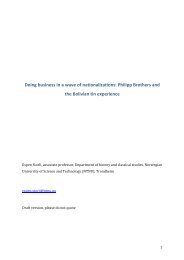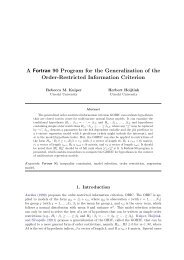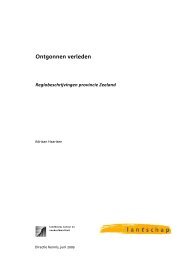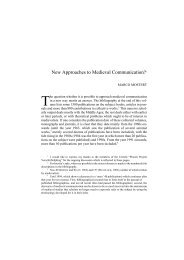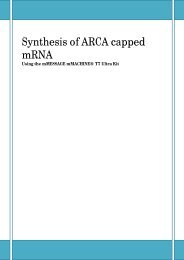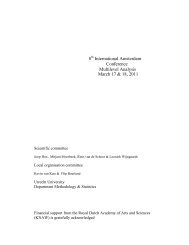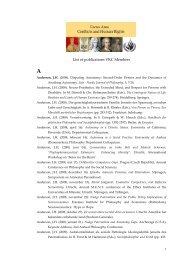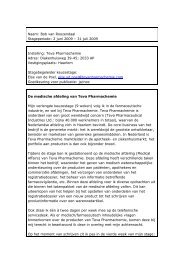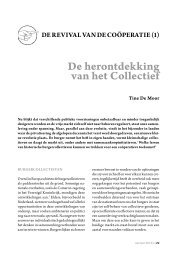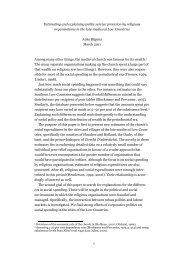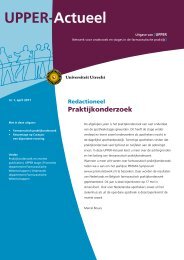CH8.Ewout Frankema.education.pdf
CH8.Ewout Frankema.education.pdf
CH8.Ewout Frankema.education.pdf
- No tags were found...
You also want an ePaper? Increase the reach of your titles
YUMPU automatically turns print PDFs into web optimized ePapers that Google loves.
247) put the number of students enrolled in 1908 at ca. 46.000, of which ca. 27.000were enrolled in Protestant and 19.000 in Catholic mission schools. What seems certain,however, is that the numbers increased spectacularly after 1908, to approximately100.000 in 1913, 150.000 in 1921 and 350.000 in 1929. For the period 1930-1960 theBelgian Annuaire Statistique provides annual accounts of the number and type ofschools and the number of students enrolled. For the post-colonial era I used the officialestimates presented in the UNESCO Statistical Yearbooks.Another major problem concerns the lack of reliable population data. Census takersfaced the sheer impossible task to survey immense hinterland areas without anydeveloped infrastructure. Moreover, the death toll due to the sleeping sickness pandemicand Leopold’s aggressive rubber policies, make it extremely difficult to estimate thesize of the population on the basis of backward extrapolation from postwar censusestimates. The short-cut I applied is to backward extrapolate the post-1950 populationseries with a fixed annual growth rate of 1.0%, which has just one advantage: it’stransparent. Therefore it’s good to know that changes in the assumed population growthrate (to 0,5 or 2%) will not alter the following main observations.First, there was a dramatic collapse of school enrolment rates in the Congo during the1980s and 1990s, after a decade of stagnation in the 1970s. This was just one of themany tragic effects of the social, political and economic deterioration whichcharacterized the major part of Mobutu’s thirty year’s rule. Exactly in this periodIndonesian gross enrolment rates started to exceed 100%, indicating that not only theaim of universal primary <strong>education</strong> was accomplished, but that it was also combinedwith a major reparation effort among higher age cohorts.Second, figure 1 shows that enrolment rates in the Belgian Congo surpassed enrolmentrates in the Netherlands Indies in the three decades between 1920 and 1950. In BelgianCongo the expansion of enrolment followed a gradual upward trend between 1910 and1970 with a few minor interruptions in the early 1940s (WWII) and the late 1950s(independence). In Indonesia the colonial era was set apart from the post-colonial era bya major trend break. Before 1940 gross primary school enrolment rates did not surpass20%. During the years of the Japanese occupation (1942-1945) enrolment rates evenhalved. The big push to mass <strong>education</strong> occurred right after the end Indonesia’sdeclaration of independence in 1945. Enrolment rates jumped from 20 to 80% of theschool age population in less than two decades between 1945 and 1962.Third, the relative success of the missionary approach in the Belgian Congo alsoappears from a broader African comparative perspective. Belgian Congo was part of aselect group of mainly British African colonies such as the Rhodesia’s (Zambia andZimbabwe), Nyasaland (Malawi) and Uganda with gross enrolment rates (age 5-14)surpassing 20% at the eve of the Second World War. This was higher than the BritishAfrican average (18.2%) and much higher than the French (5.4%) or Portuguese African(5.3%) average (<strong>Frankema</strong>, 2011). Primary school enrolment in the Dutch East Indies,on the other hand, fell considerably behind those of the neighbour countries such asBritish Malaya, Formosa (Taiwan) and the Philippines. In Thailand enrolment rateswere even three times as high as in the Netherlands Indies (Furnivall, 1943).7



